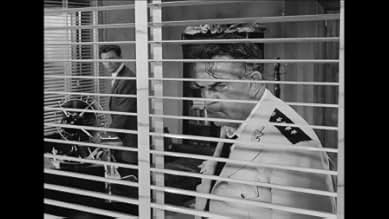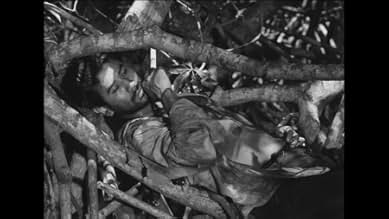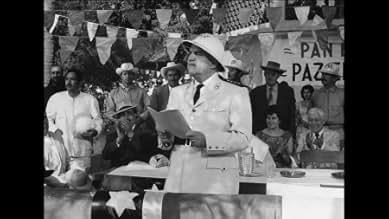La fièvre monte à El Pao
- 1959
- 1h 37m
ÉVALUATION IMDb
6,8/10
1,4 k
MA NOTE
Ajouter une intrigue dans votre langueAfter a Caribbean despot's murder, two men compete for his widow Ines on Ojeda, a prison island. When a hardliner takes power and targets his rival, bureaucrat Vazquez seeks support from loc... Tout lireAfter a Caribbean despot's murder, two men compete for his widow Ines on Ojeda, a prison island. When a hardliner takes power and targets his rival, bureaucrat Vazquez seeks support from locals and inmates to remove him.After a Caribbean despot's murder, two men compete for his widow Ines on Ojeda, a prison island. When a hardliner takes power and targets his rival, bureaucrat Vazquez seeks support from locals and inmates to remove him.
María Félix
- Inés Rojas
- (as Maria Felix)
Miguel Ángel Ferriz
- Le gouverneur Mariano Vargas
- (as M.A. Ferriz)
Raúl Dantés
- Le lieutenant García
- (as Raoul Dantes)
Armando Acosta
- Manuel
- (uncredited)
Edmundo Barbero
- Le procureur
- (uncredited)
Augusto Benedico
- Le ministre Sáenz
- (uncredited)
Antonio Bravo
- Le juge
- (uncredited)
José Chávez
- Le chauffeur transportant Inès Rojàs
- (uncredited)
Avis en vedette
One of Bunuel's most straightforward films and his most openly political, a drama about an idealist trying to foment rebellion in the fictional town of El Pao. Lacking Bunuel's comic sensibilities or surrealist touch, it's a pretty cut-and-dry affair with few surprises. The social commentary is sharp enough, but the film lacks zing and never seems to get off the ground. The highlight is the sultry performance by Maria Felix as the duplicitous wife of the governor. She gives Bunuel a chance to inject some of his sexual power dynamics and incorporate them into the political sphere. Otherwise, somewhat watchable but unengaging.
This is a comparatively obscure entry in the Luis Bunuel canon and although the whole is less than the sum of its parts, this never less than intriguing director has given us a combination of pot boiler and seering political statement.
The mercurial and charismatic Gérard Philippe plays a man whose idealistic principles cause incalculable damage and the poignancy of his well-meaning but tragic character is enhanced by a visibly ailing actor who was to die of liver cancer four months after filming was completed.
It must be said that the 'fever' of the title doesn't really amount to much as the anticipated mutiny by the prisoners takes place off screen but of course the temperature is guaranteed to rise and the pulse to quicken whenever the force of nature that is Maria Félix is on the premises. The film's most effective scene, for this viewer at any rate, is that in which her apparent submission to Jean Servais is in fact a triumph of dominance. Servais is a splendid villain and as always, his soulful expression evinces our sympathy no matter how nefarious the character he is playing.
Bunuel was not especially fond of this film and evidently regretted not having provided Philippe with a more worthy swansong. During the filming Bunuel happened to ask his leading man: "Why did you agree to make this film?" When Philippe said: "I don't know. And you?" the director replied: "I don't know either."
The mercurial and charismatic Gérard Philippe plays a man whose idealistic principles cause incalculable damage and the poignancy of his well-meaning but tragic character is enhanced by a visibly ailing actor who was to die of liver cancer four months after filming was completed.
It must be said that the 'fever' of the title doesn't really amount to much as the anticipated mutiny by the prisoners takes place off screen but of course the temperature is guaranteed to rise and the pulse to quicken whenever the force of nature that is Maria Félix is on the premises. The film's most effective scene, for this viewer at any rate, is that in which her apparent submission to Jean Servais is in fact a triumph of dominance. Servais is a splendid villain and as always, his soulful expression evinces our sympathy no matter how nefarious the character he is playing.
Bunuel was not especially fond of this film and evidently regretted not having provided Philippe with a more worthy swansong. During the filming Bunuel happened to ask his leading man: "Why did you agree to make this film?" When Philippe said: "I don't know. And you?" the director replied: "I don't know either."
for me, its basic virtue is to be the last film of Gerard Philipe. and an experiment , with decent result, of Bunuel trip in politic noir genre. it is far to be a good or a bad movie. because the genre was defined by Costa Gavras , it was very popular in "60 decade and it seems have the status of fragile equilibrium between themes, motifs, explanations, pretexts. the meet between Maria Felix and Jean Servais does the presence of Gerard Philipe almost symbolic. sure, at the second view, his Vazques becomes more realistic but more as the honest young man against a corrupt regime, in clothes of David against Goliath. short, a good film for another side of Bunuel art. for a reasonable portrait of dictatorship. and for few references to Soviet Union. or Franz Kafka.
For a director like Luis Bunuel,this is a holding pattern movie.Bunuel is neither Costa Gavras nor Alan J Pakula and his political plot falls short of its goal.What's definitely lacking here is madness,the surrealism,almost present at least in one sequence,dear to the great Spanish artist.His art becomes ineffective when it deals with pure drama.The irony seems tamed,subdued.Maria Felix's part is sometimes some kind of Maupassant's "Boule de suif" (a character from the nineteenth century),sometimes some kind of thirties Marlene Dietrich (Sternberg's "dishonored").In a nutshell,originality is not this character's forte.Gerard Philipe (sadly,soon to die from cancer)is miscast and ill-at -ease ,in his part of "intellectual trying to sweeten the dictature".Nevertheless,he ended his career with something more commendable than the disastrous Vadim's "les liaisons dangereuses".
Coming after "Nazarin" "la mort en ce jardin" or "cela s'appelle l'aurore",and preceding such masterworks as "Viridiana" "Belle de Jour" or "Tristana", this fever is not so hot.
Coming after "Nazarin" "la mort en ce jardin" or "cela s'appelle l'aurore",and preceding such masterworks as "Viridiana" "Belle de Jour" or "Tristana", this fever is not so hot.
Known as «Los ambiciosos» in México, the co-producing country where director Luis Buñueñ relocated to, lived and died, as well as in most Latin American territories, this was made in 1959, the year Fidel Castro took power in Cuba, so while anyone can believe the plot and location refers to him and his homeland, they do not. Yes, the island of Ojeda is a Caribbean country ruled by a dictator (Andrés Soler at his meanest - he does receive credit in the Mexican version), but its banana-based economy (no sugar, tobacco or rum, as in Cuba) and the absence of a guerrilla movement, makes it "NowhereLand" with Gérard Philipe (in his last role) as a handsome idealist who falls for the wrong woman (María Félix looking very beautiful). In any case we will never know if Buñuel or in that case novelist Henri Castillou were able to see the future. A good political melodrama.
Le saviez-vous
- AnecdotesIn his memoirs, Buñuel claims to have plagiarized the plot of this film from Puccini's opera "Tosca".
- Générique farfeluHalf of the credits are displayed at the beginning of the film: the first seven member of the cast, director, writers, director of photography, composer, conductor, production companies, and executive producer. The closing credits display the other half (after the word "FIN"): Once again the cast list but this time the first eight actors, then the assistant director, script supervisor, unit manager, sound engineer, production manager, followed by the name of the dubbing facilities and laboratories.
- ConnexionsReferenced in Gérard Philipe: un homme pas un ange (2003)
Meilleurs choix
Connectez-vous pour évaluer et surveiller les recommandations personnalisées
Détails
- Durée1 heure 37 minutes
- Couleur
- Mixage
Contribuer à cette page
Suggérer une modification ou ajouter du contenu manquant

Lacune principale
By what name was La fièvre monte à El Pao (1959) officially released in Canada in English?
Répondre
















